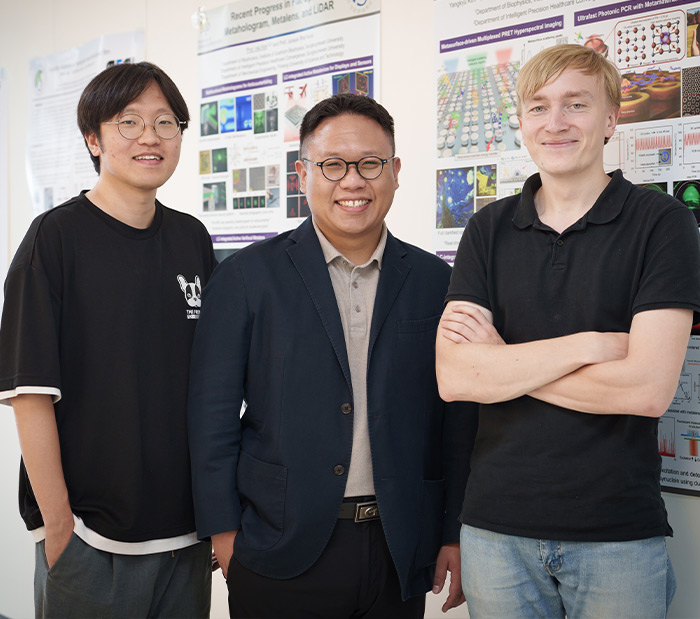Research Stories
Development of hyperspectral imaging and multiplexing sensor technology using a metasurface
An ultra-thin flat optical component with a thickness of just one-thousandth of a hair's width
Biophysics
Prof.
KIM, INKI
Kim Yangkyu, Aleksandr Barulin Researcher
Professor Inki Kim's research team from the Department of Biophysics at Sungkyunkwan University, in collaboration with Professor Luke Lee from Harvard Medical School, Professor Junsuk Rho from POSTECH, and Professor Inhee Choi from University of Seoul, has developed a hyperspectral imaging technology using a metasurface chip for real-time monitoring of cells.
Hyperspectral imaging technology is a technique that allows the simultaneous observation of both the shape and spectral signals of objects through a microscope. Through this technique, when observing objects, it is possible to obtain both spatial and temporal information about the object's location and chemical composition simultaneously. The ability to detect and monitor various biological processes occurring within cells, as well as chemically related substances directly or indirectly, in real-time from within or outside the cell, is considered a crucial technology for enabling early diagnosis of various diseases and the development of therapeutic agents. In this study, a technology was developed that utilizes Plasmonic Resonance Energy Transfer (PRET) to detect the molecular fingerprint of target chemical substances through a label-free approach.
The sensor technology based on Plasmonic Resonance Energy Transfer (PRET) exploits the phenomenon of energy transfer between plasmonic scatterers and absorbing molecules. This allows the extraction of chemical information or electronic state of molecules as a form of plasmonic quenching dips. However, conventional nanoparticle-based PRET sensors have limitations due to the restricted scattering characteristics of nanoparticles, allowing measurement of only one type of molecule at a time. Furthermore, there has been a challenge in real-time monitoring of substance transfer occurring between cells and within cells due to these limitations. Additionally, in order to accurately and in real-time monitor the spatial and temporal changes within cells, a more precise chip-based device implementation is required.
The research team has developed hyperspectral imaging and multiplexing sensor technology using a metasurface, an ultra-thin flat optical component with a thickness of just one-thousandth of a hair's width (Figure 1). A metasurface refers to a two-dimensional sub-wavelength structures that can manipulate wave properties at the interfaces. The metasurface chip can manipulate the scattering characteristics of light and has been utilized to create optical components that scatter only the desired wavelengths of light in the visible spectrum (Figure 2). The team confirmed that the metasurface chip can simultaneously detect different types of molecules, such as cytochrome and chlorophyll, which play crucial roles in the metabolism of animal and plant cells, respectively. Cytochrome is a crucial enzyme involved in electron transport chains and serves as an indicator of cellular health, while chlorophyll acts as an optical antenna, absorbing light energy for photosynthesis in plant cells.
Furthermore, the research team has introduced a technology that allows real-time quantitative detection of reactive oxygen species secreted by living cells using this metasurface chip. They developed a technique on the metasurface chip where normal cells, cancer cells, and drug-treated cancer cells were cultured, and the reactive oxygen species produced by each cell were monitored using a label-free approach (Figure 3). Over the course of an hour, they monitored the amount of reactive oxygen species emitted from the same positions within the cells, observing a higher secretion of reactive oxygen species in the order of drug-treated cancer cells, general cancer cells, and normal cells. This technology is anticipated to be applied as a drug screening platform in the future. Through this study, the metasurface chip-based hyperspectral imaging and sensor technology that has been implemented hold the potential not only for detecting various chemical substances within cells but also for real-time monitoring of cellular secretions used in intercellular communication.
The results of this study were officially published in the highly prestigious journal Advanced Materials (IF = 32.086) on August 10th and have been recognized for the excellence of the research, being selected as the cover article for that issue.
▲ Figure1. hyperspectral imaging and multiplexing sensor technology using a metasurface
▲ Figure4. Advanced Materials Cover Photo


